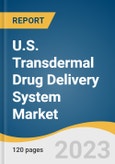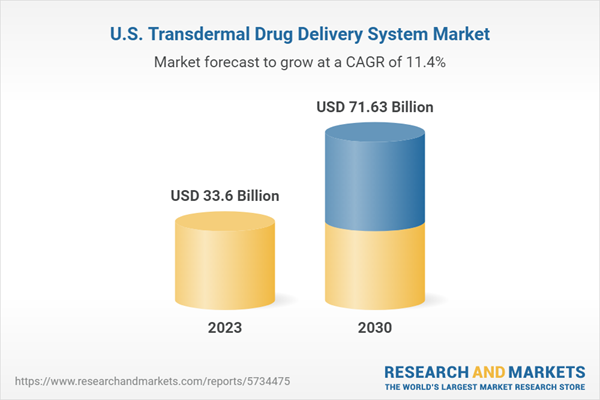Incorporation of the transdermal drug delivery system also promotes self-reliance in patients and results in a significant reduction in the frequency of hospital visits, which in turn reduces the overall treatment cost. Moreover, it also makes it very convenient for the patients to administer medications on time without any help. Furthermore, consistent technological advancements, the presence of major market players, and high funding by the government in R&D represent favorable growth for the market in the U.S.
The COVID-19 pandemic had a moderately negative impact on the transdermal drug delivery system market. While most markets struggled to make revenues in line with the pre-COVID years, the U.S. transdermal drug delivery market managed to generate it. However, there was a drop in the overall growth rate, which the market quickly recovered in the second half of the pandemic.
Continuous research to expand the usage of transdermal drug delivery systems across different applications is expected to propel the growth of the market. In addition, consistent efforts by the key players to introduce new products in the market that will serve as a better alternative to conventional drug delivery systems represent lucrative growth opportunities.
U.S. Transdermal Drug Delivery System Market Report Highlights
- Based on technology, the iontophoresis segment dominated the market in 2022 due to its advantages while administering drugs non-invasively
- The mechanical arrays technology segment is expected to generate maximum growth due to increasing usage in aesthetics and the launch of new products
- Based on application, the pain management segment held the highest market share in 2022 due to increasing demand for these systems in pain management
- The cardiovascular application segment is expected to experience the fastest growth over the forecast period due to effective results while using these devices in the treatment of cardiovascular diseases
- The presence of major players and the availability of technologically advanced products is expected to lead to the continuous growth of the market in the U.S.
Table of Contents
Chapter 1. Methodology and Scope1.1. Market Segmentation & Scope
1.1.1. Technology
1.1.2. Application
1.1.3. Country scope
1.1.4. Estimates and forecast timeline
1.2. Research Methodology
1.3. Information Procurement
1.3.1. Purchased database
1.3.2. internal database
1.3.3. Secondary sources
1.3.4. Primary research
1.3.5. Details of primary research
1.3.5.1. Data for primary interviews in the U.S.
1.4. Information or Data Analysis
1.4.1. Data analysis models
1.5. Market Formulation & Validation
1.6. Model Details
1.6.1. Commodity flow analysis (Model 1)
1.6.2. Approach 1: Commodity flow approach
1.6.3. Volume price analysis (Model 2)
1.6.4. Approach 2: Volume price analysis
1.7. List of Secondary Sources
1.8. List of Primary Sources
1.9. Objectives
1.9.1. Objective 1
1.9.2. Objective 2
Chapter 2. Executive Summary
2.1. Market Outlook
2.2. Segment Outlook
2.2.1. Technology Outlook
2.2.2. Application Outlook
2.2.3. Country Outlook
2.3. Competitive Insights
Chapter 3. U.S. Transdermal Drug Delivery System Market Variables, Trends & Scope
3.1. Market Lineage Outlook
3.1.1. Parent market outlook
3.1.2. Related/ancillary market outlook
3.2. Penetration & Growth Prospect Mapping
3.3. Industry Value Chain Analysis
3.3.1. Reimbursement framework
3.4. Market Dynamics
3.4.1. Market driver analysis
3.4.1.1. Increasing Prevalence of Chronic Diseases
3.4.1.2. Technological Advancements
3.4.1.3. High Demand for Pain-Free Drug Delivery
3.4.2. Market restraint analysis
3.4.2.1. High Cost of Transdermal Technology
3.4.2.2. Limited Number of Approved Medications
3.5. U.S. Transdermal Drug Delivery System Market Analysis Tools
3.5.1. Industry Analysis - Porter’s
3.5.1.1. Supplier power
3.5.1.2. Buyer power
3.5.1.3. Substitution threat
3.5.1.4. Threat of new entrant
3.5.1.5. Competitive rivalry
3.5.2. PESTEL Analysis
3.5.2.1. Political landscape
3.5.2.2. Technological landscape
3.5.2.3. Economic landscape
3.5.3. Major Deals & Strategic Alliances Analysis
3.5.4. Market Entry Strategies
Chapter 4. U.S. Transdermal Drug Delivery System Device: Technology Estimates & Trend Analysis
4.1. Definitions and Scope
4.1.1. Electroporation
4.1.2. Radio Frequency
4.1.3. Iontophoresis
4.1.4. Microporation
4.1.5. Thermal
4.1.6. Mechanical arrays
4.1.7. Ultrasound
4.1.8. Others
4.2. Technology Market Share, 2022 & 2030
4.3. Segment Dashboard
4.4. U.S. Transdermal Drug Delivery System Market by Technology Outlook
4.5. Market Technology & Forecasts and Trend Analyses, 2018 to 2030 for the following
4.5.1. Electroporation
4.5.1.1. Market estimates and forecast 2018 - 2030 (Revenue in USD Billion)
4.5.2. Radio Frequency
4.5.2.1. Market estimates and forecast, 2018 - 2030 (Revenue in USD Billion)
4.5.3. Iontophoresis
4.5.3.1. Market estimates and forecast, 2018 - 2030 (Revenue in USD Billion)
4.5.4. Microporation
4.5.4.1. Market estimates and forecast, 2018 - 2030 (Revenue in USD Billion)
4.5.5. Thermal
4.5.5.1. Market estimates and forecast, 2018 - 2030 (Revenue in USD Billion)
4.5.6. Mechanical Arrays
4.5.6.1. Market estimates and forecast, 2018 - 2030 (Revenue in USD Billion)
4.5.7. Ultrasound
4.5.7.1. Market estimates and forecast, 2018 - 2030 (Revenue in USD Billion)
4.5.8. Others
4.5.8.1. Market estimates and forecast, 2018 - 2030 (Revenue in USD Billion)
Chapter 5. U.S. Transdermal Drug Delivery System: Application Estimates & Trend Analysis
5.1. Definitions and Scope
5.1.1. CNS
5.1.2. Pain Management
5.1.3. Cardiovascular
5.1.4. Hormone
5.1.5. Immunological
5.1.6. Metabolic
5.1.7. Gastrointestinal
5.1.8. Infection
5.1.9. Cancer
5.1.10. Others
5.2. Application Market Share, 2022 & 2030
5.3. Segment Dashboard
5.4. U.S. Transdermal Drug Delivery System Market by Application Outlook
5.5. Market Application & Forecasts and Trend Analyses, 2018 to 2030 for the following
5.5.1. CNS
5.5.1.1. Market estimates and forecast, 2018 - 2030 (Revenue in USD Billion)
5.5.2. Pain Management
5.5.2.1. Market estimates and forecast, 2018 - 2030 (Revenue in USD Billion)
5.5.3. Cardiovascular
5.5.3.1. Market estimates and forecast, 2018 - 2030 (Revenue in USD Billion)
5.5.4. Hormone
5.5.4.1. Market estimates and forecast, 2018 - 2030 (Revenue in USD Billion)
5.5.5. Immunological
5.5.5.1. Market estimates and forecast, 2018 - 2030 (Revenue in USD Billion)
5.5.6. Metabolic
5.5.6.1. Market estimates and forecast, 2018 - 2030 (Revenue in USD Billion)
5.5.7. Gastrointestinal
5.5.7.1. Market estimates and forecast, 2018 - 2030 (Revenue in USD Billion)
5.5.8. Infection
5.5.8.1. Market estimates and forecast, 2018 - 2030 (Revenue in USD Billion)
5.5.9. Cancer
5.5.9.1. Market estimates and forecast, 2018 - 2030 (Revenue in USD Billion)
5.5.10. Others
5.5.10.1. Market estimates and forecast, 2018 - 2030 (Revenue in USD Billion)
5.5.10.2. Urological
5.5.10.2.1. Market estimates and forecast, 2018 - 2030 (Revenue in USD Billion)
5.5.10.3. Blood Disorders
5.5.10.3.1. Market estimates and forecast, 2018 - 2030 (Revenue in USD Billion)
5.5.10.4. Respiratory
5.5.10.4.1. Market estimates and forecast, 2018 - 2030 (Revenue in USD Billion)
5.5.10.5. Musculoskeletal
5.5.10.5.1. Market estimates and forecast, 2018 - 2030 (Revenue in USD Billion)
Chapter 6. U.S. Transdermal Drug Delivery System Market: Country Estimates & Trend Analysis
6.1. U.S. market share analysis, 2022 & 2030
6.2. U.S. Market Dashboard
6.3. U.S. Market Snapshot
6.4. U.S. Market Share and Leading Players, 2022
6.5. Market Application, & Forecasts and Trend Analysis, 2018 to 2030
6.6. U.S.
6.6.1. Market estimates and forecast, 2018 - 2030 (Revenue, USD Billion)
Chapter 7. Competitive Landscape
7.1. Recent Developments & Impact Analysis, By Key Market Participants
7.2. Company/Competition Categorization
7.2.1. Innovators
7.2.2. Market Leaders
7.2.3. Emerging Players
7.3. Vendor Landscape
7.3.1. List of key distributors and channel partners
7.3.2. Key customers
7.3.3. Key company market share analysis, 2022
7.3.4. Novartis AG
7.3.4.1. Company overview
7.3.4.2. Financial performance
7.3.4.3. Product benchmarking
7.3.4.4. Strategic initiatives
7.3.5. Johnson & Johnson
7.3.5.1. Company overview
7.3.5.2. Financial performance
7.3.5.3. Product benchmarking
7.3.5.4. Strategic initiatives
7.3.6. Viatris Inc.
7.3.6.1. Company overview
7.3.6.2. Financial performance
7.3.6.3. Product benchmarking
7.3.6.4. Strategic initiatives
7.3.7. Boehringer Ingelheim GmbH Overview
7.3.7.1. Financial performance
7.3.7.2. Product benchmarking
7.3.7.3. Strategic initiatives
7.3.8. Biogel Technology, Inc.
7.3.8.1. Company overview
7.3.8.2. Financial performance
7.3.8.3. Product benchmarking
7.3.8.4. Strategic initiatives
7.3.9. 3M Company
7.3.9.1. Company overview
7.3.9.2. Financial performance
7.3.9.3. Product benchmarking
7.3.9.4. Strategic initiatives
7.3.10. Noven Pharmaceuticals, Inc.
7.3.10.1. Company overview
7.3.10.2. Financial performance
7.3.10.3. Product benchmarking
7.3.10.4. Strategic initiatives
7.3.11. 4P Therapeutics, LLC
7.3.11.1. Company overview
7.3.11.2. Financial performance
7.3.11.3. Product benchmarking
7.3.11.4. Strategic initiatives
7.3.12. Transdermal Corporation
7.3.12.1. Company overview
7.3.12.2. Financial performance
7.3.12.3. Product benchmarking
7.3.12.4. Strategic initiatives
7.3.13. Echo Therapeutics, Inc.
7.3.13.1. Company overview
7.3.13.2. Financial performance
7.3.13.3. Product benchmarking
7.3.13.4. Strategic initiatives
List of Tables
Table 1 List of Abbreviations
Table 2 U.S. transdermal drug delivery system market, by technology, 2018 - 2030 (USD Billion)
Table 3 U.S. transdermal drug delivery system market, by application, 2018 - 2030 (USD Billion)
List of Figures
Fig. 1 Market research process
Fig. 2 Data triangulation techniques
Fig. 3 Primary research pattern
Fig. 4 Primary interviews in the U.S.
Fig. 5 Market research approaches
Fig. 6 Value-chain-based sizing & forecasting
Fig. 7 QFD modeling for market share assessment
Fig. 8 Market formulation & validation
Fig. 9 Transdermal drug delivery system: market outlook
Fig. 10 Transdermal drug delivery system market competitive insights
Fig. 11 Parent market outlook
Fig. 12 Related/ancillary market outlook
Fig. 13 Penetration and growth prospect mapping
Fig. 14 Industry value chain analysis
Fig. 15 Transdermal drug delivery system market driver impact
Fig. 16 Transdermal drug delivery system market restraint impact
Fig. 17 Transdermal drug delivery system market strategic initiatives analysis
Fig. 18 Transdermal drug delivery system market: Technology movement analysis
Fig. 19 Transdermal drug delivery system market: Technology outlook and key takeaways
Fig. 20 Electroporation estimates and forecast, 2018 - 2030
Fig. 21 Radio Frequency market estimates and forecast, 2018 - 2030
Fig. 22 Iontophoresis market estimates and forecast, 2018 - 2030
Fig. 23 Microporation estimates and forecast, 2018 - 2030
Fig. 24 Thermal market estimates and forecast, 2018 - 2030
Fig. 25 Mechanical arrays market estimates and forecast, 2018 - 2030
Fig. 26 Ultrasound market estimates and forecast, 2018 - 2030
Fig. 27 Others market estimates and forecast, 2018 - 2030
Fig. 28 Transdermal drug delivery system market: application movement analysis
Fig. 29 Transdermal drug delivery system market: application outlook and key takeaways
Fig. 30 CNS estimates and forecast, 2018 - 2030
Fig. 31 Pain Management estimates and forecast, 2018 - 2030
Fig. 32 Cardiovascular estimates and forecast, 2018 - 2030
Fig. 33 Hormone estimates and forecast, 2018 - 2030
Fig. 34 Immunological estimates and forecast, 2018 - 2030
Fig. 35 Metabolic estimates and forecast, 2018 - 2030
Fig. 36 Gastrointestinal estimates and forecast, 2018 - 2030
Fig. 37 Infection estimates and forecast, 2018 - 2030
Fig. 38 Cancer estimates and forecast, 2018 - 2030
Fig. 39 Others estimates and forecast, 2018 - 2030
Fig. 40 Urological estimates and forecast, 2018 - 2030
Fig. 41 Blood disorders estimates and forecast, 2018 - 2030
Fig. 42 Respiratory estimates and forecast, 2018 - 2030
Fig. 43 Musculoskeletal estimates and forecast, 2018 - 2030
Fig. 44 U.S. Transdermal drug delivery system market: Country movement analysis
Fig. 45 U.S. Transdermal drug delivery system market: Country outlook and key takeaways
Fig. 46 U.S. market share and leading players
Fig. 47 U.S.
Fig. 48 U.S. market estimates and forecast, 2018 - 2030
Fig. 49 Participant categorization- Transdermal drug delivery system market
Fig. 50 Market share of key market players- Transdermal drug delivery system market
Companies Mentioned
- Novartis AG
- Johnson & Johnson
- Viatris Inc.
- Boehringer Ingelheim GmbH Overview
- Biogel Technology, Inc.
- 3M Company
- Noven Pharmaceuticals, Inc.
- 4P Therapeutics, LLC
- Transdermal Corporation
- Echo Therapeutics, Inc.
Table Information
| Report Attribute | Details |
|---|---|
| No. of Pages | 120 |
| Published | January 2023 |
| Forecast Period | 2023 - 2030 |
| Estimated Market Value ( USD | $ 33.6 Billion |
| Forecasted Market Value ( USD | $ 71.63 Billion |
| Compound Annual Growth Rate | 11.4% |
| Regions Covered | United States |
| No. of Companies Mentioned | 10 |









